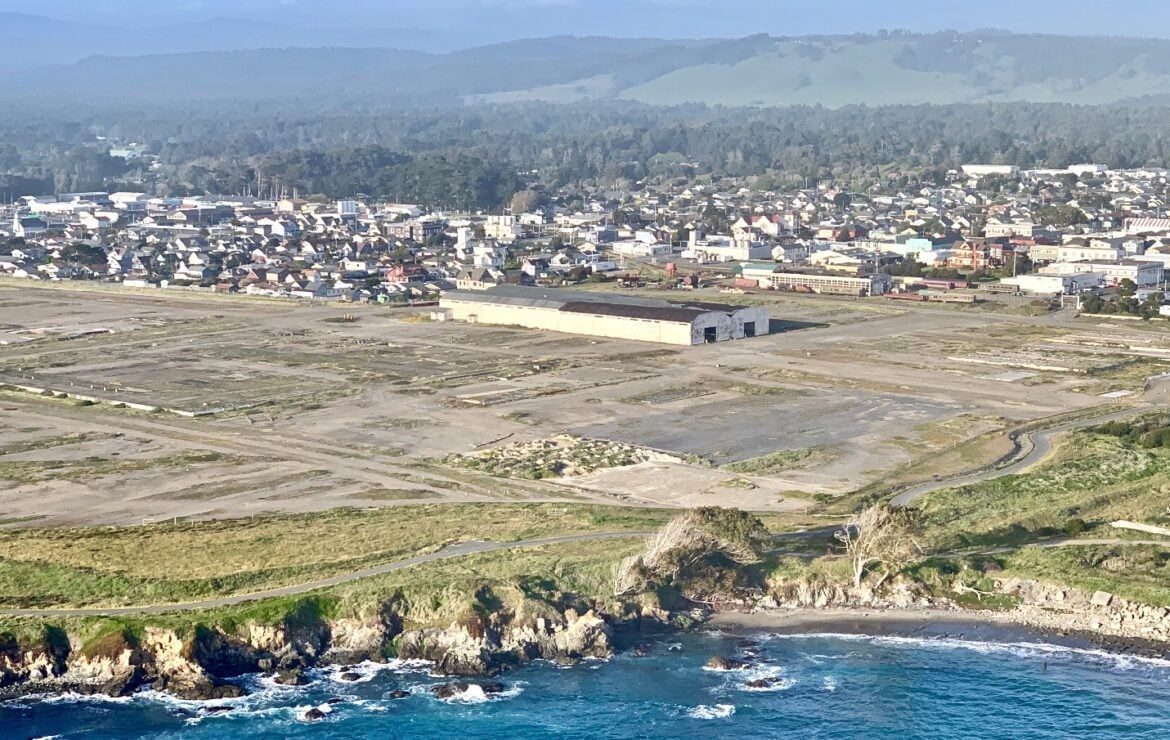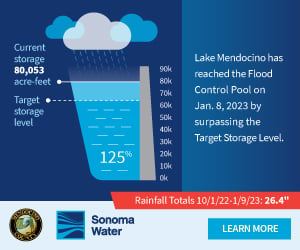FORT BRAGG, 11/24/21 — A feud has been brewing between the city of Fort Bragg and the owners of the Skunk Train for several months, and things are starting to come to a head. Last week, Georgia Pacific agreed to cede almost 300 acres of the millsite to Mendocino Railway, which filed an eminent domain claim in August. But the city was planning on using the site as the hub for its blue, ocean-based economy and says reopening the connection to Willits would open up the possibility of the rail being used to transport coal to China instead.
On Monday night, the city of Fort Bragg voted unanimously to send a letter to U.S. Department of Transportation (DOT) Under Secretary Carlos Monje requesting the department deny Mendocino Railway’s application for a Railroad Rehabilitation & Improvement Financing loan. That loan is intended to repair Tunnel No. 1, which connected Willits and Fort Bragg before it collapsed in 2013, but the city’s letter states it should be denied on the basis that the railway is an excursion train and not a public utility. The city actually filed a complaint in Mendocino County Superior Court on Oct. 28 asking the railway no longer be considered a public utility and disqualified as a “federally regulated common carrier providing transportation.” That’s currently making its way through court.
“The proposed repair of the collapsed tunnel, rebuilding of the North Coast Railroad Authority (NCRA) line and active freight and passenger service is simply a ruse to hold onto the designation as a common carrier so that Mendocino Railway can develop the 350 acres in Fort Bragg without having to comply with state and local regulations,” the letter states.
Fixing the collapsed tunnel is crucial to expanding service, including transporting freight, Mike Hart, CEO of Sierra Railroad Company, the parent company of Mendocino Railway, told The Mendocino Voice. Mendocino Railway applied for a $31.3 million loan from the DOT with Sierra Northern Railway in June to do the work. Hart said he believed the request to have the DOT deny the railway’s loan application was the city’s attempt to retaliate against the company for acquiring the millsite property through eminent domain.
Comments from members of the City Council suggested that’s partly true. “Eminent domain is a tool for public agencies to use for the public good,” said Vice Mayor Jessica Morsell-Haye. “So here is the Skunk Train doing a land grab for 272 acres in our small city on the assertion that they need it for their railway operations.” Morsell-Haye pointed to a letter sent to the council from conservation nonprofit Friends of the Eel River, which asserted that the plan to connect the Skunk Train to a larger rail system was actually part of an effort to export coal to China.
Hart said that couldn’t be further from the truth and the nonprofit was conflating the Skunk Train’s plans with those of another company that is also trying to prevent the North Coast Railroad Authority (NCRA) from decommissioning the rail lines stretching across Sonoma, Mendocino and Humboldt counties in order to establish the Great Redwood Trail. That trail is expected to stretch from Cloverdale to Blue Lake along the rail lines in question, and Hart said he’d prefer to see the trail alongside the rail rather than replacing it.
The other company might be trying to export coal from Humboldt Bay, but Hart said the Mendocino Railway has been working on plans for transporting freight, like propane, for years. “Having trash, instead of being hauled over Highway 20, moving it by rail,” Hart said. “Water, supplies, lumber — all of these things that are currently the big trucks going over Highway 20, we would like to see it moved by rail.”
The mill used to employ most of the city at one point, but it’s been shuttered for about 20 years. The community has been working on plans for how the site should be developed for almost that entire time. But Georgia Pacific, the millsite owner, didn’t want to develop the site. It wanted only to remediate the environmental damage caused by the industrial operations there before passing off the site to someone else. Mendocino Railway expressed interest in the site and Hart said that the company did everything it could to incorporate everything the city wanted into its plans to develop the site.
“When we acquired the 77 acres in July of 2019, by the end of September, just two months after we finished the purchase, we had a complete plan … that reflected the city’s plan for that property,” Hart said, adding that’s the same plan described in The Little Stinker newsletter sent out to county residents Friday, Nov. 19. “We went to the city and said, ‘What do you want?’ They said, ‘We want housing, we need a hotel, we need commercial, we want open space.’ And we said sure, as long as it had our railroad tracks we were fine with everything they wanted.”
The city abandoned that planning process and was allowing it to be a developer-driven plan, Hart said. City Councilmember Lindy Peters contested that, saying the city’s been working for the past six or seven years to develop an amendment to the city general plan’s coastal element to address future development at the millsite. “Anytime you go through a rezone in the coastal zone, it takes a long time,” Peters said. “Whether it’s a specific plan or whether it’s an amendment. At this point, we decided to rezone the millsite, it would be quicker and cheaper and just as efficient to do an amendment rather than go through a specific plan.”
On top of that, tens of millions of dollars worth of investment is also needed in the property before a single building can be constructed and the city doesn’t necessarily have the ability to serve new development, as demonstrated by the drought emergency this past summer. And the actual amount of contamination from industrial operations that took place there is still unknown, potentially adding millions more dollars to cleanup costs.
The city had been working with the Skunk Train to develop a portion of the millsite, but Peters said the Skunk Train owners were disingenuous the first time Tunnel No. 1 collapsed, saying it would be fixed in no time. “What was that? Seven years ago,” Peters said. Now the city is skeptical that the company is actually committed to the cleanup of the site. The Skunk Train isn’t the city’s enemy, but Peters said, “Right now, we feel as though we’re being hung out to dry.”
You can watch the full Fort Bragg City Council meeting here: Facebook Live | Facebook






Why do you what to take incoming tours and people that live here for a 100.years or more and change what thay have had in care for and change it. We like the train and it your history and been here for all your children to in joy. Everytime you change things like this you take away the things everyone that lived on the coast for more then fifty years. Away from them and there children will never get to ride the train with there grandpa like I did. His name Harvey Brown chief of Willits fire Department. And he cared about the train.
The contention that the RR expansion would facilitate shipping coal to Chine is PURE BULLSNOT… The NWPRR / NCRA line north of Willits will 95% probability never see a train again… the Eel River Canyon rails were the most expensive in the US to maintain because of the constant land slides.
And Humboldt Bay will most likely never be dredge & developed for freight ships, and freight ship sure as hell can’t dock at Ft Bragg.
And also, consider the NWPRR / NCRSA line from Cloverdale to Willits most likely not be rehabilitated & put back into service… maybe as a Class 2 Railroad at best.
Coastal residents found something interesting in their mailboxes and post office boxes this past week –” The Little Stinker”. The four color 8-page 11×17 newsprint newsletter entitled “The Little Stinker” (yep that is the name of it!) put out by the Mendocino Railway/Skunk Train/Sierra Energy outfit looks like it puts forth some ambitious development that runs roughshod over the City of Ft. Bragg’s Mill Site Specific Plan. The Mill Site Plan was informed by hours of public scoping sessions and expert input with keeping in mind the General Plan Update processes and Local Coastal Program (LCP) amendments, etc.
The “Little Stinker” makes a whole host of claims one of which states, “Taking ownership of a large portion of the historic coastal Mill Site, the Skunk Train will work with experts to develop a world class-destination, breathing new life into this unique stretch of coastline.”
Hmmn? Who is the “stinker” that says taking ownership will trump public input and all the General Plan zoning, and policies and guidelines set forth by Ft. Bragg City Council and which in turn must be certified by the Coastal Commission?
This tourist train with its ticket office/depot located at the Foot of East Laurel Street is much loved and one of the main attractions in Ft. Bragg’s historic downtown Who is in charge of Fort Bragg’s future is the question.
The Skunk Train public relations press releases keeps shifting including with some unrealized plans over the years, and more so, ever so recently, to fit what appears to be the whim of private development.
This time, as indicated in the “Little Stinker,” it is about the increasing the railroad’s footprint along the former Georgia Pacific Mill site with expanding enterprises as in hotels, condos and a sundry of what not transport ideas. All that and more are part of the scheme of things. Is this all really about investors and developers’ ocean side dream property? A Cypress Station at Cypress Street on Highway 1 with a restaurant?
Why now is this enterprise claiming rights as a federally operating railroad? Hmmn? By the way who has been paying into the Railroad Retirement and Survivor Benefits for the Skunk Train R.R. employees? Many more questions need to be asked here.
Meanwhile precarious geological complications have not once but twice have put this tourist excursion train out of action.
The Skunk Train’s Round House in Ft. Bragg has been in disrepair for years. The former Mill Site dry sheds still stand waiting for their promise of rebuild and repair. The area public wants daylighting of creeks and the toxic cleanup on the closed areas of the Mills Site and so on.
Are the tracks and bridges along the railroad’s switch backs and canyons still stable on the way to Willits? Who keeps it all in repair along the rugged terrain?
The Skunk Train tunnel west end collapsed in 2015 and the east end collapsed in 2013. In 1998 Rail-Ways Inc. private freight operator for NCRA Line north of Willits closed because of slides.
In 1989 a series of devastating storms flooded the Eel River to record heights effectively destroying the line between Willits and Eureka forcing its closure. Further storms and subsidence closed the section from Willits south to Petaluma.
In February 2001, after repairs, the NWP resumed operations south of Petaluma. However, the Federal Railroad Administration (FRA) declared the track unfit for traffic in October 2001 and operations ceased. Not sure what is in the mix now after all that.
A skunk does not change its stripes and the Skunk Train – a tourist train it is!
According to the Federal Railroad Administration, “Tourist, scenic, historic, or excursion operations are railroad operations that carry passengers, often using antiquated equipment, with the conveyance of the passengers to a particular destination not being the principal purpose.”
Imminent domain? BS they give tourists rides for an exorbitant amount of money for a 45 minute ride to nowhere. It’s lovely, but not public transportation. Monopolization of something that is not in the community’s best interest. It’s sad and I hope they fail.
Sounds like a Land Grab for Monied developers. And polititions to help them get a lot for nothing. Same Old Story. When will people wise up?
I’m strongly in favor of developing and maintaining railway systems, especially when they are used for a combination of freight and passenger conveyance.
While The Skunk Train may not currently be able to offer more than excursions, with funding it could absolutely be a service to the public once again.
I have read many times this year of the water being trucked in daily from Ukiah to the Mendocino Coast; that could be sent the majority of the way by rail instead. Reducing the amount of freight going by trucks would absolutely make the drive safer and less frustrating for residents who share the highway, and residents with no access to cars could benefit by being able to travel between towns by train. Especially here on the west coast, completely abandoning railways as public transport in favor of becoming a “car culture” only has not done anyone any favors.
I look forward to the Skunk Train receiving its funding necessary to restore the line and expand its service. There are many examples worldwide of heritage railways that act as both tourist excursion railways and convenient commuter service for residents, and I would be proud to have one so near my hometown!
Development, or re-development, of a passenger and freight carrying railroad regardless of the FRA class will allow many tractor-trailer combinations to not have to be used in that greater area.
What about being able to collect trash and recycles from the city and even other communities, load it into shipping containers on railcars, and roll it on down to a larger city where Sierra has a GtL/Fischer-Tropsch facility to turn waste into products, added value products, and byproducts. Further, the locomotive power for any of these revenue trains could be powered using a hydrogen- or hybrid- -fueled engine, though products/byproducts from a GtL/Fischer-Tropsch facility could power it as well.
Those products, added value products, and byproducts could even benefit the city in 🆂🅾🅼🅴 way.
Supporting this railroads expanded services helps many people in the community in many ways as the more revenue the rxr makes the more money enters Mendocino county and offers many benifits. They are not after chugging coal through the area at all either